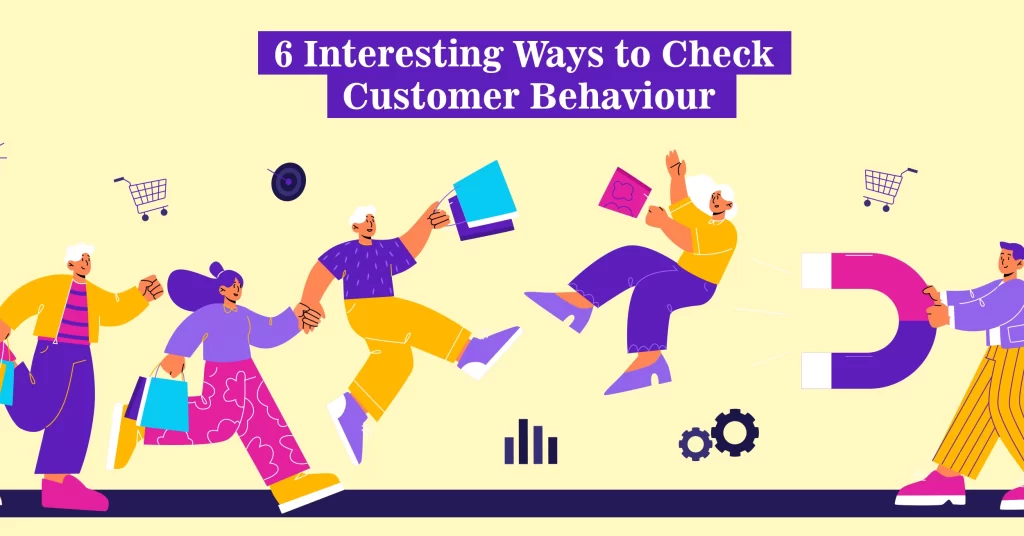- Understanding Consumer Behaviour in Digital Marketing
- 6 Factors That Affect Customer Behavior in Digital Marketing
- 6 Interesting Ways to Check Customer Behaviour in Digital Marketing
- How To Improve Customer Behaviour in Digital Marketing?
- Improve Your Website Design with Analytics and Heatmaps
- Take Action Based on Social Media Listening Insights
- Surveys can be used to improve products and services.
- Optimize the Customer Experience Using User Journey Mapping
- A/B testing can be used to personalize content
- Using Behavioural Email Analytics, Create Targeted Email Campaigns
Consider browsing your favourite online store. You’re drawn to a product like a fashionable pair of sneakers. You read reviews, compare prices, and eventually buy. This process exemplifies customer behaviour in the digital market, from discovery to decision. It is the online journey that customers take, which is influenced by various factors, and understanding it is critical for businesses to tailor their strategies effectively. But, there is more to explore about customer behaviour in digital marketing.
So, join us as we explore the world of customer behaviour in digital marketing! In this blog, which Mohit’s SEO Training supports, we will look at the factors influencing how customers behave online. Let us simplify customer behaviour in digital marketing!
Also Read: Challenges of Digital Marketing
Understanding Consumer Behaviour in Digital Marketing
Consumer behaviour is increasingly important in shaping the success of marketing strategies in the digital age. Likewise, it refers to how people make decisions, interact with content, and interact with brands online. Thus, understanding consumer behaviour in digital marketing is essential while some factors affect it:
- The ease and satisfaction that users experience when using a website or app significantly impacts their behaviour.
- Tailoring content and recommendations to user preferences increases engagement and influences decision-making.
- Customer reviews, testimonials, and social media all impact the perceived value of a product or service.
- High-quality, relevant content captures attention and builds trust, influencing customers.
- .It is critical to have easy navigation, quick access to information, and smooth transactions.
- A positive brand image and reputation enhance trust and customer loyalty.
- The effectiveness and relevance of online advertisements influence customer perceptions and choices.
- Product ratings and reviews on platforms like Yelp or Google influence customer trust and decisions.
- Economic conditions, discounts, and promotions all impact digital purchasing behaviour.
6 Factors That Affect Customer Behavior in Digital Marketing
Let’s know each one:
1 User Experience Design
The user experience design, which is informed by heatmaps and analytics, has a significant impact on customer behavior. Likewise, users’ exploration and interaction with the site is influenced by intuitive navigation, visually appealing layouts, and strategically placed elements. Businesses can optimize website design for a seamless and engaging experience that captivates visitors and encourages prolonged interaction.
2 Perception of Social Media
Monitoring brand or industry-related mentions, comments, and discussions on social media provides a window into customer sentiments. Advanced tools can even analyze the sentiment of interactions to reveal how customers perceive products or services. This real-time understanding enables businesses to adjust their strategies, respond to emerging trends, and address areas for improvement.
3 Surveys and Customer Feedback
Direct feedback mechanisms, such as surveys and feedback forms, are invaluable tools for understanding and influencing customer behavior. Businesses can gather targeted insights by placing easily accessible feedback forms on their websites and after specific interactions. The key is to ask questions that probe into the customer’s beliefs and motivations. Analyzing responses not only helps businesses improve their products and services, but also guides them in tailoring their offerings to align with customer expectations, influencing future purchasing decisions.
4 Optimized User Journey
From initial brand discovery to significant purchases, the user journey provides critical insights into customer behavior. This detailed visualization enables businesses to identify areas where customers may encounter difficulties or drop off. Likewise, businesses can actively guide customers through a seamless and satisfying journey by optimizing touchpoints and addressing potential pain points. As a result, customer behavior improves, encouraging continued engagement and lowering conversion barriers.
5 Results of A/B Split Testing
A/B testing, also known as split testing, is a dynamic tool for refining digital content based on performance metrics. This method compares two versions of a webpage, email, or advertisement to see which performs better. Moreover, through analyzing user responses to different versions, businesses gain insights into audience preferences and behaviors. A/B split testing guides marketers in creating content that resonates more effectively with their audience.
6 Behavioral Email Analytics
Behavioral email analytics look beyond open and click rates to see how recipients interact with email content. Likewise, businesses gain nuanced insights by examining which links are clicked, how long readers engage with specific sections, and whether certain content types lead to conversions. This data serves as a catalyst for tailoring future email campaigns to customer interests.

6 Interesting Ways to Check Customer Behaviour in Digital Marketing
We have some exciting ways to check customer behaviour in digital marketing. Let’s know each one of them:
Heatmaps and analytics
Analytics tools like Google Analytics provide significant insight into information about user behaviour. You can monitor which pages users visit, how long they explore on each page, and what actions they take. Heatmaps take this further by visualizing where users click, move, or lose interest in a website. Moreover, understanding these patterns aids in the optimization of website design and content placement to provide a more user-friendly experience.
Monitoring Social Media
Monitoring social media platforms for brand or industry-related mentions, comments, and discussions is what social media listening entails. Likewise, advanced tools can analyze the sentiment behind these interactions, allowing you to see how your customers perceive your products or services. Active listening can teach you a lot about emerging trends, customer preferences, and areas for improvement.
Forms of feedback and surveys
Surveys and feedback forms are direct tools for gathering customer feedback. Likewise, make feedback forms easily accessible on your website or after specific interactions, and create targeted surveys to gather particular insights. Moreover, the primary key is to ask questions about what customers believe and why they believe it. Analyzing responses aids in the improvement of products, services, and the overall customer experience.
Mapping the User Journey
User journey mapping entails visualizing the entire customer journey, from discovering your brand to making a big purchase. You can identify areas where customers may drop off or face challenges by mapping out touchpoints and potential pain points. In addition, this comprehensive perspective assists in optimizing each stage of the customer journey for a more seamless and satisfying experience.
A/B Split Testing
A/B testing, aka Split testing, involves the comparison of two versions of a webpage, email, or advertisement to determine which performs better. Similarly, this method allows you to try out headlines, images, and calls-to-action elements. You can choose which version resonates more with your audience by analyzing the performance metrics of each version, providing insights into their preferences and behaviours.
Analytics for Behavioural Email
Behavioural email analytics are more than open and click rates. They investigate how recipients interact with your emails. Examine which links are clicked, how long readers spend on particular sections, and whether certain types of content lead to conversions. In addition, this information aids in tailoring future email campaigns to customer interests, resulting in higher engagement and conversion rates.
Implementing these strategies allows you to observe customer behaviour and make data-driven decisions, fine-tune your digital marketing approach, and ultimately improve the overall customer experience.
Also Read: Father of Digital Marketing

How To Improve Customer Behaviour in Digital Marketing?
While one can observe the factors affecting consumer behaviour in digital marketing, there’s always space for improvement:
Improve Your Website Design with Analytics and Heatmaps
- First, set up an analytics tool (such as Google Analytics) to track user behaviour on your existing website.
- Examine data for high-traffic pages, bounce rates, and user journey patterns.
- Use heatmaps (such as Hotjar) to see where users click, move, and spend time on pages.
- Determine which areas have low engagement or a high drop-off rate.
- Based on user behaviour insights, redesign or optimize these sections.
Take Action Based on Social Media Listening Insights
- Monitor brand mentions, comments, and sentiments using social media listening tools (e.g., Hootsuite, Brandwatch).
- Sort feedback into positive, negative, and neutral categories.
- Provide solutions or clarifications to negative feedback as soon as possible.
- Recognize and amplify positive feedback to improve brand image.
- Incorporate social listening-identified trending topics and preferences into your content strategy.
Also Read: Performance Marketing vs Digital Marketing
Surveys can be used to improve products and services.
- Create surveys with tools such as Google Forms or SurveyMonkey.
- Inquire about the customer’s preferences, problems, and suggestions for improvement.
- Incentivize survey participation to increase response rates.
- Examine the survey results for recurring themes or areas for improvement.
- Implement improvements based on customer feedback and communicate them.
Optimize the Customer Experience Using User Journey Mapping
- Create user journey maps to visualize the touchpoints between awareness and conversion.
- Identify potential friction points or areas where users may abandon their journey.
- Simplify and streamline each touchpoint to create a unified experience.
- Run the optimized journey by real users to get feedback.
- Iterate and refine the journey map based on user feedback.
A/B testing can be used to personalize content
- Choose a content element to test (for example, headlines, images, or CTAs).
- Make two variations (A and B) for the chosen element.
- Divide your audience into groups and show each group a different variation.
- Track each variant’s performance metrics (such as click-through rates and conversions).
- Implement the better-performing variation and repeat the process.
Using Behavioural Email Analytics, Create Targeted Email Campaigns
- Use email marketing platforms that support tracking customer behaviour in digital marketing (e.g., Mailchimp, HubSpot).
- Examine open rates, click-through rates, and conversion rates.
- Determine user preferences for content or products based on their behaviour.
- Based on these preferences, segment your email list.
- Lastly, design personalized email campaigns for each segment, incorporating suggestions and incentives.
Following these step-by-step procedures regularly will enable you to actively use customer behaviour insights to improve your digital marketing strategies.

Mohit Verma is an experienced professional with 9 years of experience in Search Engine Optimization. He has worked with many brands such as Bank of Baroda, 1boxoffice, and Ozonetel. He is on a mission to provide industry focused job oriented SEO and Google Ads Training, so the students/mentees can go and start working from day 1.
